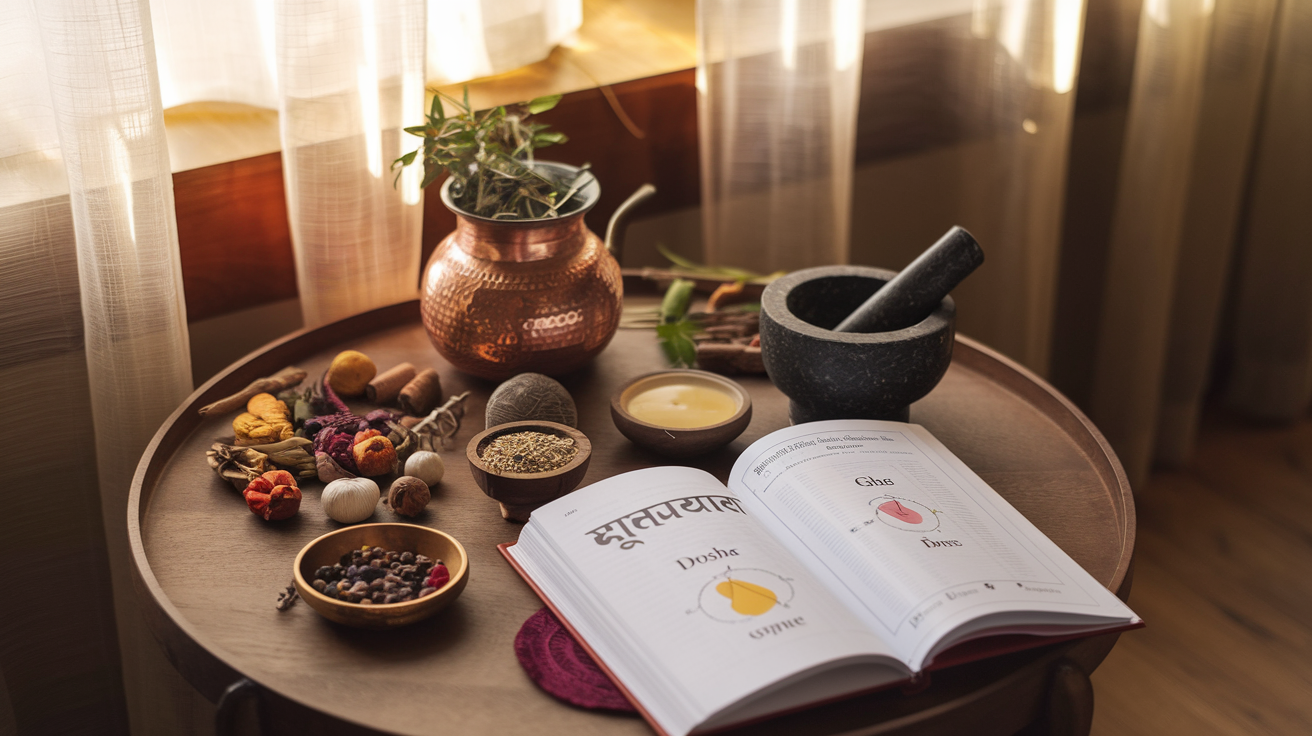
Ever caught yourself rushing through your morning routine on autopilot, feeling disconnected from your body and wondering why you're constantly exhausted? You're not alone. Nine out of ten people report feeling disconnected from their natural rhythms in our notification-driven world.
What if your everyday habits could become powerful anchors for wellness instead of just items to check off your to-do list?
Ayurvedic rituals offer exactly this transformation – they're not about adding more to your plate but bringing intention to what you already do. These ancient practices help you realign with your body's natural rhythm, creating lasting wellness that feels effortless rather than another obligation.
But here's what most wellness guides won't tell you about implementing Ayurveda in modern life...
Understanding Ayurveda's Foundational Principles

The Three Doshas Explained: Vata, Pitta, and Kapha
Imagine your body as a unique blend of energies that shape everything from your appetite to your sleep patterns. That's essentially what Ayurveda's doshas are all about.
Think of doshas as your body's natural operating systems. Everyone has all three, but most of us have one or two that dominate. These aren't just abstract concepts – they directly impact how you feel day to day.
Vata is like the wind – always moving. If you're primarily Vata, you're likely creative, quick-thinking, and maybe a bit anxious when out of balance. Physically, you might run cold, have dry skin, and need extra help staying grounded.
Pitta brings the fire. Pitta-dominant folks are naturally sharp, focused, and driven. You've probably got a strong metabolism but might overheat easily – both physically and emotionally. When your Pitta's off-kilter, that determination can turn into irritability faster than you can say "take a breath."
Kapha embodies earth and water energies – stable, nurturing, and steady. Kapha types have amazing endurance but can get stuck in routines. You likely have smooth skin, sleep deeply, and need extra motivation to get moving sometimes.
How Doshas Influence Daily Rhythms and Habits
Your dominant dosha doesn't just determine your personality traits – it shapes your entire day.
Morning feels different depending on your constitution. Vata types often wake early but might feel scattered. Pittas rise with purpose and hunger. Kaphas? They could sleep through three alarms if left unchecked.
Even your ideal exercise varies: quick-changing activities for Vatas, competitive sports for Pittas, and steady strength training for Kaphas.
Your doshas aren't static either – they fluctuate throughout the day:
-
6am-10am: Kapha time (heavy, slow energy)
-
10am-2pm: Pitta time (peak productivity)
-
2pm-6pm: Vata time (creative, variable energy)
This cycle repeats through the evening, explaining why you might feel sluggish mid-morning or suddenly creative at odd hours.
The Concept of Dinacharya (Daily Routine) in Ayurveda
Dinacharya isn't just a schedule – it's a rhythm that aligns you with nature's intelligence.
The magic of an Ayurvedic routine lies in its predictability. When your body knows what's coming next, it operates more efficiently. This isn't about rigid rules – it's about finding flow.
Key elements of dinacharya include:
-
Rising before sunrise (ideally during Brahma muhurta, 4-6am)
-
Tongue scraping and oil pulling for oral health
-
Abhyanga (self-massage) with warm oil
-
Eating your largest meal at midday when digestion peaks
-
Winding down as the sun sets
These practices aren't random – they're strategic moves that counter imbalances before they take root.
Identifying Your Unique Constitution for Personalized Wellness
Finding your dominant dosha isn't just interesting – it's your personal roadmap to feeling amazing.
Watch your natural tendencies. Do you get cold easily? Vata might be strong. Always hungry? Hello, Pitta. Love naps? Kapha might be calling the shots.
Your constitution goes beyond a simple quiz. Look at your:
-
Body frame and weight distribution
-
Digestion patterns and food preferences
-
Sleep habits and energy fluctuations
-
Emotional responses to stress
Remember – imbalance happens when you live against your nature. A Vata trying to live a Pitta lifestyle will burn out. A Kapha following Vata practices might feel ungrounded.
The beauty of Ayurveda is its personalization. No one-size-fits-all advice – just alignment with your true nature.
Morning Rituals to Awaken Your Body's Natural Energy

Tongue scraping to remove overnight toxins
Ever wake up with that funky morning breath and a coated tongue? That's the aftermath of your body's natural detox process while you sleep. In Ayurveda, this coating is called "ama" – basically toxins your body wants to kick out.
Tongue scraping isn't just some hipster wellness trend. This ancient practice helps remove bacteria, food debris, and toxins that accumulate on your tongue overnight. Skip this step, and guess what? You're basically swallowing those toxins back into your system. Gross, right?
Grab a copper or stainless steel tongue scraper (not plastic – they harbor bacteria), stick your tongue out, and gently scrape from back to front 7-14 times. It takes literally 20 seconds but makes a world of difference for your breath and digestion.
Oil pulling for oral health and detoxification
Oil pulling sounds fancy but it's super simple. Swish a tablespoon of organic sesame or coconut oil around in your mouth for about 15-20 minutes before spitting it out.
The oil works like a magnet, pulling bacteria and toxins from places your toothbrush can't reach. Your grandma's mouthwash could never.
Morning is prime time for this ritual – bacteria multiply overnight while you sleep. Regular oil pulling brightens teeth, strengthens gums, and some people swear it helps with everything from headaches to hormone balance.
Just remember to spit the oil in the trash, not down your drain (unless you want your plumber on speed dial).
Abhyanga (self-massage) to stimulate circulation
Think of abhyanga as giving yourself some morning love. This self-massage with warm oil wakes up your entire body and gets your blood flowing like nothing else.
Different oils work for different doshas:
-
Vata: sesame oil (warming and grounding)
-
Pitta: coconut oil (cooling and soothing)
-
Kapha: sunflower oil (light and stimulating)
Start with your scalp, then work down to your face, limbs, and torso using long strokes on limbs and circular motions on joints. Take at least 5-10 minutes with this. Your skin will drink it up, and you'll feel energized yet calm.
Proper hydration practices to jumpstart metabolism
Forget reaching for coffee first thing. In Ayurveda, how you hydrate matters as much as what you hydrate with.
Start with room temperature water – cold water shocks your system and dampens your digestive fire. Add a squeeze of lemon to stimulate your liver and kick digestive juices into gear.
Sip slowly rather than chugging. Your body absorbs water better this way, and you'll avoid that sloshy feeling. Aim for about 16oz within 30 minutes of waking – it flushes your digestive tract and helps your body clear yesterday's waste.
Mindful breakfast choices aligned with your dosha
Breakfast isn't one-size-fits-all in Ayurveda. Your morning meal should balance your dominant dosha:
Vata types need warm, nourishing foods like oatmeal with ghee and spices. Skip the cold smoothies – they'll leave you feeling anxious and bloated.
Pitta folks do well with cooling foods like sweet fruits and coconut yogurt. Heavy, spicy breakfasts will only feed that fiery temper.
Kapha types need light, stimulating foods – think warm quinoa with spices or a small portion of stewed apples with ginger. Heavy, sweet breakfasts will have you dragging all day.
Eat mindfully, without screens. It seems small, but chewing thoroughly and appreciating your food activates digestion and sets a centered tone for your entire day.
Midday Practices for Sustained Energy and Focus

A. Timing meals according to digestive fire (agni)
Ever notice how some days you're starving by 11 AM, and other days you can cruise until 2 PM without a stomach growl? That's your agni talking – your digestive fire that's central to Ayurvedic wellness.
Your body's natural rhythm peaks around noon. This is when your digestive fire burns brightest. Eating your largest meal between 12-1 PM works with this natural surge, not against it. When you sync your meals with these natural rhythms, you'll notice less bloating, better energy, and clearer thinking.
Look for these signs your meal timing is on point:
-
Food digests without discomfort
-
Energy remains steady (no post-lunch crashes)
-
Hunger returns naturally before your next meal
The trick isn't just when you eat, but how you eat. Rush through lunch at your desk while answering emails? Your digestion suffers. Take 20 minutes to sit, chew thoroughly, and appreciate your food? That's showing respect to your agni.
B. Strategic movement to balance your dominant dosha
Midday exercise doesn't need to mean a full gym session. Think strategic, dosha-specific movement that resets your energy for the afternoon ahead.
Vata types (creative, quick-moving, easily scattered) benefit from grounding movements. A 15-minute walking meditation or gentle yoga flow with standing poses creates stability when the afternoon scatter threatens.
Pitta types (focused, intense, easily irritated) need cooling, non-competitive movement. Swimming, a leisurely bike ride, or flowing yoga in a normal-temperature room helps release that midday tension without stoking your internal fire.
Kapha types (steady, calm, easily stagnant) thrive with energizing movement. A brisk walk, dance break, or dynamic yoga sequence wakes up your system when that afternoon heaviness creeps in.
The key is consistency over intensity. Five minutes of the right movement for your dosha beats an hour of the wrong type.
C. Breathwork techniques to reset your nervous system
Your breath is the remote control for your nervous system. And midday is prime time for a reset.
Try this: Step away from your desk, find a quiet spot, and try Nadi Shodhana (alternate nostril breathing). Cover your right nostril, inhale through the left, then cover the left, exhale through right. Reverse and repeat for 2 minutes. This simple practice balances both hemispheres of your brain and calms your nervous system instantly.
For quick energy: Kapalabhati (skull-shining breath) works wonders. Take a deep breath in, then exhale forcefully through your nose with a quick abdominal contraction. Let inhalations happen naturally between sharp exhalations. Just 30 seconds will clear mental fog.
For cooling down: Sitali breath (curled tongue breathing) helps when you're overheated or stressed. Curl your tongue into a tube, inhale through it like a straw, close your mouth, exhale through your nose. Repeat 5-10 times to feel your temperature and tension drop.
These midday reset practices take minutes but deliver hours of improved focus, energy and balance – exactly when you need it most.
Evening Rituals for Deep Restoration

Digital detox strategies to calm the mind
Night time scrolling is killing your sleep quality. I'm not exaggerating - that blue light is actually signaling your brain to stay awake when it should be winding down. In Ayurveda, this disrupts your natural doshas, especially aggravating Vata energy that needs calming in the evening.
Try these simple detox strategies:
-
Set a non-negotiable digital curfew 1-2 hours before bed
-
Replace phone time with a physical book (not an e-reader!)
-
Create a charging station outside your bedroom
-
Use the "Do Not Disturb" function to silence notifications
Your brain will thank you. Most people report feeling less anxious and more rested within just three days of implementing these boundaries.
Warming foods and drinks that promote digestion
Your digestive fire (agni) naturally weakens as the day progresses. That's why that late-night ice cream often sits like a rock in your stomach.
Dinner should be your lightest meal, ideally consumed before 7pm. Focus on these warming, easy-to-digest options:
-
Steamed vegetables with ghee
-
Kitchari (mung bean and rice porridge)
-
Warming soups with digestive spices like ginger, cumin and fennel
-
Stewed fruits instead of raw ones
After dinner, sip on CCF tea (cumin-coriander-fennel) or ginger tea with a touch of honey. These simple drinks stoke your digestive fire without overworking your system overnight.
Self-care practices for releasing accumulated stress
The day's stress gets stored in your body, and if you don't release it, it compounds. Here's how to dump that baggage before bed:
Abhyanga (self-massage) is a game-changer. Warm some sesame oil (for Vata), coconut oil (for Pitta), or mustard oil (for Kapha) between your palms and massage your body in long strokes toward your heart. This practice grounds scattered energy and signals your nervous system that it's safe to relax.
Other powerful practices include:
-
Legs-up-the-wall pose for 5-10 minutes
-
Gentle forward folds to release back tension
-
Writing down tomorrow's to-dos so your mind can let go
-
A 5-minute breathing practice: 4 counts in, 7 counts hold, 8 counts out
Creating the optimal sleep environment for your dosha type
Your bedroom setup should match your unique dosha needs:
Vata types need extra warmth and coziness. Use heavy blankets, warm colors, and maybe a small sound machine for white noise. Your sensitive nervous system craves consistency, so stick to regular bedtimes.
Pitta types run hot. Keep your bedroom cool and use light, breathable bedding in blues and greens. Blackout curtains are essential since you're sensitive to light.
Kapha types benefit from stimulating colors like oranges and purples, and should avoid heavy bedding that makes it harder to get up in the morning. Open a window for fresh air circulation.
Regardless of dosha, keep electronics out and use essential oils like lavender, chamomile, or vetiver to signal your brain it's time for deep, restorative sleep.
Seasonal Adjustments to Your Ayurvedic Routine

Adapting rituals for winter wellness
Winter's chill doesn't just call for thicker sweaters – your body needs different care too. During these darker months, Vata dosha (air and space elements) naturally increases, often leading to dry skin, stiff joints, and that scattered feeling you can't shake.
Your morning routine needs a winter upgrade. Skip the ice-cold shower that worked in summer and opt for warm water instead. Your body will thank you. A quick self-massage with warming sesame oil before bathing locks in moisture and improves circulation when you need it most.
Notice how your appetite changes? That's your body's wisdom. Winter calls for heartier, warmed foods – think nourishing soups, stews, and cooked root vegetables. Raw salads that felt refreshing in July might leave you feeling unsatisfied and cold now. Add warming spices like ginger, cinnamon, and black pepper to kindle your digestive fire.
Sleep patterns shift with the seasons too. In winter, aim for bed by 10pm and allow yourself those extra morning moments under the covers. Your body craves more rest when daylight hours shrink.
Summer practices to balance excess heat
Summer brings Pitta dosha (fire and water elements) into full force. You'll notice it in irritability, skin rashes, or that quick temper that flares when you're overheated.
Cool down your morning routine. Those brisk walks? Schedule them for early morning or evening when the sun isn't blazing. A room-temperature shower with a touch of cooling coconut oil afterward helps your skin retain moisture without trapping heat.
Your diet needs a seasonal shift too. Summer calls for lighter meals that don't overheat your system. Fresh fruits, steamed vegetables, and cooling herbs like mint and cilantro keep internal temperatures balanced. Cut back on spicy foods, alcohol, and excessive caffeine – all Pitta aggravators.
Hydration becomes crucial now. Not just water (though plenty of that), but cooling drinks like coconut water, lime juice with mint, or a thin yogurt lassi help maintain electrolyte balance when you're sweating more.
Transitional season protocols for body harmony
Spring and fall – those in-between times – often throw your body's rhythms into confusion. These transitions demand flexibility in your routines.
During spring's Kapha-dominant energy (earth and water), focus on movement to counter sluggishness. Dry brushing before morning showers stimulates lymphatic flow and helps shed winter's heaviness. Incorporate more bitter greens and astringent tastes to cut through accumulated heaviness.
Fall transitions call for stability as Vata increases. Ground yourself with regular mealtimes and a consistent sleep schedule. This isn't the season to experiment with drastic changes or cleanses. Your nervous system needs reassurance, not revolution.
Both transitional seasons benefit from mindful breathing practices. Simple alternate-nostril breathing for 5 minutes daily helps smooth the adjustment between seasons, balancing your nervous system when it's most vulnerable to disruption.
Measuring Success: The Signs of Ayurvedic Balance

Physical indicators of improved rhythmic alignment
Your body talks. It's constantly sending signals about your overall health, and when you're in rhythm with Ayurvedic practices, these signals become quite positive.
First thing most people notice? Better sleep. Not just more hours, but deeper rest that actually rejuvenates you. You'll wake up feeling refreshed instead of hitting snooze five times.
Digestion changes too. That bloated feeling after meals? Gone. Regular bowel movements become, well, regular. Your appetite normalizes—you get hungry at consistent times and cravings for junk food drop off.
Your skin clears up. That dullness gets replaced by a natural glow that no expensive cream could deliver. Hair becomes shinier, nails stronger.
Energy levels stabilize—no more afternoon crashes where you're desperately reaching for caffeine. You'll notice sustainable energy throughout the day.
Mental clarity and emotional stability markers
The mind fog lifts. Seriously.
When you're practicing Ayurvedic rituals consistently, decision-making becomes less overwhelming. That mental chatter quiets down, and you can actually focus on one task without your brain jumping to fifteen different worries.
Sleep quality improvement directly impacts your emotional resilience. Small stresses that used to derail your entire day? They bounce off more easily.
Your reactions change too. Instead of immediate anger or anxiety, there's a space—a pause where you can choose your response instead of just reacting.
Memory improves. Names, tasks, details—they stick better when your body and mind are in alignment.
Long-term benefits of consistent ritual practice
The daily rituals compound over time. It's like putting money in a wellness bank account—the interest keeps growing.
Immunity strengthens. You'll notice fewer sick days, shorter duration of illness when it does happen.
Aging process slows down. Not just looking younger, but feeling more vital and mobile as years pass.
Your intuition sharpens. Making decisions based on what truly serves you becomes more natural because you're connected to your body's wisdom.
Relationships improve because you're showing up as your best self—less reactive, more present, with energy to truly engage.
Troubleshooting common challenges in establishing new habits
New habits get derailed. It happens to everyone. Here's how to fix the usual suspects:
Morning time crunch? Start with just one five-minute ritual. Tongue scraping takes 30 seconds. Oil pulling can happen while you shower.
Traveling throws off your routine? Pack a mini-kit with essential items—tongue scraper, small oil bottle, spice packets for easy digestion support.
Family members think you've gone weird? Don't preach, just practice. Let your results speak for themselves.
Feeling overwhelmed by information? Follow this rule: if you can only do one thing, focus on consistent mealtimes. Everything else builds from there.
Seeing no results? Track specific markers (sleep quality, energy at 3pm, mood patterns) rather than vague "feelings." Progress is often subtle before it's dramatic.

Incorporating Ayurvedic rituals into your daily routine creates powerful opportunities to reconnect with your body's innate wisdom. From morning practices that awaken your natural energy to evening rituals that promote restorative rest, these intentional habits work together to establish balance across all aspects of your being. By making seasonal adjustments and paying attention to the signs of Ayurvedic balance, you create a sustainable wellness practice that evolves with you.
The beauty of Ayurveda lies in its simplicity and accessibility. You don't need to overhaul your entire lifestyle at once—begin by incorporating one ritual that resonates with you, then gradually build upon that foundation. Listen to your body, observe how it responds, and trust the ancient wisdom that has guided well-being for thousands of years. Your journey toward balance and vitality begins with a single mindful moment.
📚 References
- Singh RH et al., 2011 – Concept of Dinacharya (daily routine) in Ayurveda and preventive health
- Patwardhan B et al., 2005 – Ayurveda and integrative medicine: aligning lifestyle with natural rhythms
- Sleep Foundation – Circadian rhythms and their role in health, energy, and wellbeing
- Frontiers in Psychology, 2018 – Daily mindfulness and intention-setting improve attention and stress regulation
- Cohen MM, 2014 – Tulsi (Holy Basil) as an adaptogen: supporting balance and resilience in everyday life




Leave a comment
This site is protected by hCaptcha and the hCaptcha Privacy Policy and Terms of Service apply.